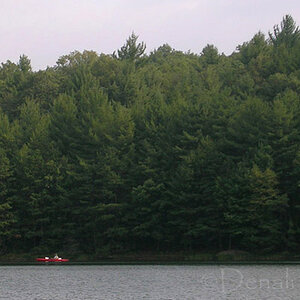exemplaria
TPF Noob!
- Joined
- Sep 18, 2012
- Messages
- 119
- Reaction score
- 19
- Location
- Minneapolis, MN
- Can others edit my Photos
- Photos OK to edit
Had this thought when thinking about PC lenses. Depth of field tends to be talked about in a 2d sense - a DOF range might be expressed as acceptable sharpness starting 50 feet from the camera and ending 100 feet from the camera. But in a real world sense, when converting a 3D world into a 2D photo, is the depth of field actually a 3D segment of 2 concentric spheres? That is, if the image is wide enough or covers enough visual space, will objects on the edge of the image eventually become blurry? From my example above, if I'm photographing a row of people who are lined up perpendicular to the direction of the camera lens, and the closest person to me is 50 feet away, someone who is 87 feet away from that person will be over 100 feet from the camera. Will they be blurry, or not? I realize after playing around with a DOF calculator my numbers may not make sense in a real world application, (as the lens would need a 120 degree range) but work with me here.
Even if I'm correct in my thinking, is this ever a real world problem? Is the radius of the "DOF sphere" equal the focus subject distance, or something else? I've shot with some super-wide lenses wide open (although that was about f4 on those lenses) but didn't seem to notice this, although I can't say I really looked for it. Is this what is happening when lenses are referred to as being soft in the corners?
Even if I'm correct in my thinking, is this ever a real world problem? Is the radius of the "DOF sphere" equal the focus subject distance, or something else? I've shot with some super-wide lenses wide open (although that was about f4 on those lenses) but didn't seem to notice this, although I can't say I really looked for it. Is this what is happening when lenses are referred to as being soft in the corners?


![[No title]](/data/xfmg/thumbnail/37/37521-5e19cc15e190997d963ed09c3c13ca9c.jpg?1619738129)

![[No title]](/data/xfmg/thumbnail/40/40310-01bec1b9b7918522bf21a09cf75c5266.jpg?1619739414)



![[No title]](/data/xfmg/thumbnail/35/35932-28690c4fc247cf491230e47fc70ebeb5.jpg?1619737235)
![[No title]](/data/xfmg/thumbnail/40/40309-c759bfd4ae7c079632e7402d21d332f1.jpg?1619739414)
![[No title]](/data/xfmg/thumbnail/37/37540-73002ccb910b97978bc38658622a34d3.jpg?1619738133)
